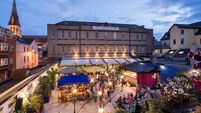Museums can help foster a sense of belonging

Patrick O'Donovan, minister for tourism, culture, arts, gaeltacht, sport and media (left) with Dr Caroline Campbell, director of the National Gallery of Ireland, viewing Picasso's 'Bust of a Woman with a Blue Hat'. The current exhibition 'Picasso from the Studio' at the National Gallery is providing free entry every Wednesday morning, presenting yet another opportunity to experience rare works up close without much of a hassle. File photo: Naoise Culhane
In an age when travel snapshots dominate our social feeds, the idea of cultural exploration has slowly become associated with airports and passport stamps. We chase museums and galleries across the world but often overlook the cultural spaces that exist a short bus ride away.
During the holiday season, when time opens up and routine pauses, there is a strong case to make for turning inward rather than outward. Local museums and galleries are not just for visitors. They are vital civic spaces where young people can connect with their country’s story, identity and creative heritage.
Ireland is fortunate to have cultural institutions that are both accessible and affordable. Many are free all year round, with youth-adult/student discounts for paid installations or special exhibitions. The National Gallery, for instance provides free entry to its permanent collections.
The National Museum has three major sites in Dublin alone, covering archaeology, decorative arts and natural history. The Museum of Literature, located on St Stephen’s Green, opens a vivid window into Ireland’s literary evolution. Smithfield’s Photo Museum recently concluded a Young Photographer’s competition and regularly features youth-led programming.
Kilmainham Goal introduces people to some of the momentous events in Irish history, which can be visited for a nominal entry fee. The National Print museum hosts workshops introducing young people to traditional printing techniques. The examples are endless.
These are not places that demand a special occasion to visit, they are open, inviting and designed to be returned to. Although it is true that educational visits organised by schools and universities do help in the cultural exposure, yet real interest and sustained connection emerge through independent visits.
When young people choose to walk into a museum on their own time, culture and history stop being a curriculum and become a curiosity. Limited free access or discounted ticket prices during holidays is just one example of how these institutions lower financial barriers.
The current exhibition 'Picasso from the Studio' at the National Gallery is providing free entry every Wednesday morning, presenting yet another opportunity to experience rare works up close without much of a hassle. Irish Museum of Modern Art is also turning out to be an attractive location for young people.

When exploring a new country, many travellers like me naturally gravitate to museums. Before seeking out scenic viewpoints or popular photo spots, some prefer to find the closest museum and immerse themselves in the visual story of that place.
Coming to Dublin for the first time offered me exactly that type of immersion. It is possible to experience a kind of Chronotope, a term used by literary theorist Mikhail Bakhtin to describe a space where time layers itself. For a moment, the present stands next to centuries of history. It becomes possible to imagine what a place looked like centuries ago and what values shaped the people who lived there.
There is a thrill to standing in front of a painting or object that has witnessed more time than we ever will. Yet today these experiences are often reduced to a tick on the bucket list. A museum becomes something to visit simply because one is travelling.
Back home, those same spaces remain invisible. As an international journalist myself, I have come to ponder upon these questions, leading to introspection. It is a question for ourselves: do we pay enough attention to the cultural heritage sites existing next door?
Regular museum visits help build what might be called cultural belonging. Identity is not formed only through personal memories. It is shaped by context, by knowing where we come from and what has come before us.
Cultural institutions hold that context. They are the physical archives of a nation’s emotional memory. Author and Illustrator Maira Kalman once wrote that a museum visit is a search for beauty, truth and meaning in our lives. The search does not require a plane ticket. It requires attention.
A painting seen at 10 looks different at 20. A historical object might carry a new meaning after a difficult year or a personal breakthrough. Meaning changes, but the museum remains.
While personal preferences shape holiday choices, when deadlines take a back seat, sprinkling a few museum visits amidst iconic sights or shopping sprees can add value. A family visit to a free gallery on a slow afternoon, or children attending a printmaking session, may be worthwhile.
Young people in Ireland travel more, consume global culture and engage with international issues. This curiosity is commendable and much needed; outward-looking should not mean looking past what is near.
Museums and galleries are living archives and tell a country’s story. They remind us that culture and history are not elsewhere; they are right here.
- Arpita Chowdhury is a journalist born in India but living now in Ireland.












